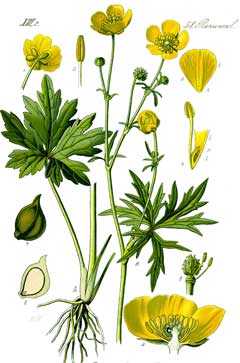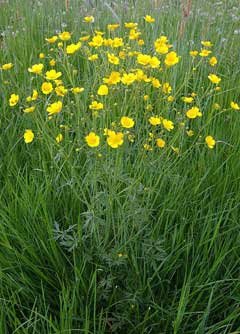 |
|
http://commons.wikimedia.org/wiki/File:Illustration_Ranunculus_acris0_clean.jpg |
 |
| http://commons.wikimedia.org/wiki/User:Fice |
Translate this page:
Summary
Physical Characteristics

 Ranunculus_acris is a PERENNIAL growing to 1 m (3ft 3in).
Ranunculus_acris is a PERENNIAL growing to 1 m (3ft 3in).
It is not frost tender. It is in flower from May to July. The species is hermaphrodite (has both male and female organs) and is pollinated by Bees, flies, beetles, Lepidoptera (Moths & Butterflies).
Suitable for: light (sandy), medium (loamy) and heavy (clay) soils. Suitable pH: mildly acid, neutral and basic (mildly alkaline) soils. It can grow in semi-shade (light woodland) or no shade. It prefers moist or wet soil.
UK Hardiness Map
US Hardiness Map
Synonyms
R. acer.
Plant Habitats
Edible Uses
Leaves - cooked and used as greens[257]. Some caution is advised, see the notes above on toxicity.
References More on Edible Uses
Medicinal Uses
Plants For A Future can not take any responsibility for any adverse effects from the use of plants. Always seek advice from a professional before using a plant medicinally.
The whole plant is acrid, anodyne, antispasmodic, diaphoretic and rubefacient[4, 21]. The plant has been crushed and applied as a poultice to the chest to relieve colds and chest pains[257]. The fresh leaves have been used as a rubefacient in the treatment of rheumatism etc[222]. The flowers and the leaves have been crushed and sniffed as a treatment for headaches[257]. An infusion of the roots has been used in the treatment of diarrhoea[257]. The poulticed root is also rubefacient and was applied to boils and abscess[222, 257]. The plant sap has been used to remove warts[4]. The sap has also been used as a sedative[257]. The flowers are used in Tibetan medicine, where they are considered to have an acrid taste and a heating potency[241]. Their use is said to promote heat, dissolve tumours and draw out serous fluids[241]. They are used in the treatment of disorders brought about by rotting sores or wounds[241]. Use with caution[21], the whole plant is extremely acrid and can cause intense pain and burning of the mouth, mucous membranes etc[222].
References More on Medicinal Uses
The Bookshop: Edible Plant Books
Our Latest books on Perennial Plants For Food Forests and Permaculture Gardens in paperback or digital formats.

Edible Tropical Plants
Food Forest Plants for Hotter Conditions: 250+ Plants For Tropical Food Forests & Permaculture Gardens.
More

Edible Temperate Plants
Plants for Your Food Forest: 500 Plants for Temperate Food Forests & Permaculture Gardens.
More

More Books
PFAF have eight books available in paperback and digital formats. Browse the shop for more information.
Shop Now
Other Uses
References More on Other Uses
Cultivation details
Prefers a moist loamy soil[1]. Grows well in marshy soils[24]. Plants are hardy to at least -20°c[187]. A good plant for the summer meadow[24]. It spreads rapidly by means of runners and is often a weed in lawns or gardens. A polymorphic species, there is at least one named variety. 'Flore Pleno' is a double-flowered form that does not spread by runners and so is unlikely to become a nuisance in the garden[187]. A greedy plant, inhibiting the growth of nearby plants, especially legumes[54].
References Carbon Farming Information and Carbon Sequestration Information
Temperature Converter
Type a value in the Celsius field to convert the value to Fahrenheit:
Fahrenheit:
The PFAF Bookshop
Plants For A Future have a number of books available in paperback and digital form. Book titles include Edible Plants, Edible Perennials, Edible Trees,Edible Shrubs, Woodland Gardening, and Temperate Food Forest Plants. Our new book is Food Forest Plants For Hotter Conditions (Tropical and Sub-Tropical).
Shop Now
Plant Propagation
Seed - sow spring in situ. You are very unlikely to need to encourage this plant. Division in spring. Very easy, though probably totally unnecessary, larger divisions can be planted out direct into their permanent positions.
Other Names
If available other names are mentioned here
Native Range
TEMPERATE ASIA: Russian Federation-Ciscaucasia (Ciscaucasia), Russian Federation-Western Siberia (Western Siberia) NORTHERN AMERICA: Greenland, United States (Alaska) EUROPE: Denmark, Finland, United Kingdom, Ireland, Iceland, Norway, Sweden, Austria, Belgium, Switzerland, Czech Republic, Germany, Hungary, Netherlands, Poland, Slovakia, Russian Federation (European part), Belarus, Estonia, Lithuania, Latvia, Ukraine, Albania, Bulgaria, Bosnia and Herzegovina, Greece (north), Croatia, Italy, North Macedonia, Romania, Serbia, Slovenia, Spain, France (incl. Corsica)
Weed Potential
Right plant wrong place. We are currently updating this section.
Please note that a plant may be invasive in one area but may not in your area so it's worth checking.
Conservation Status
IUCN Red List of Threatened Plants Status :

Growth: S = slow M = medium F = fast. Soil: L = light (sandy) M = medium H = heavy (clay). pH: A = acid N = neutral B = basic (alkaline). Shade: F = full shade S = semi-shade N = no shade. Moisture: D = dry M = Moist We = wet Wa = water.
Now available:
Food Forest Plants for Mediterranean Conditions
350+ Perennial Plants For Mediterranean and Drier Food Forests and Permaculture Gardens.
[Paperback and eBook]
This is the third in Plants For A Future's series of plant guides for food forests tailored to
specific climate zones. Following volumes on temperate and tropical ecosystems, this book focuses
on species suited to Mediterranean conditions—regions with hot, dry summers and cool, wet winters,
often facing the added challenge of climate change.
Read More
Expert comment
Author
L.
Botanical References
17
Links / References
For a list of references used on this page please go here
Readers comment
| Add a comment |
|
If you have important information about this plant that may help other users please add a comment or link below. Only comments or links that are felt to be directly relevant to a plant will be included. If you think a comment/link or information contained on this page is inaccurate or misleading we would welcome your feedback at [email protected]. If you have questions about a plant please use the Forum on this website as we do not have the resources to answer questions ourselves.
* Please note: the comments by website users are not necessarily those held by PFAF and may give misleading or inaccurate information.
To leave a comment please Register or login here All comments need to be approved so will not appear immediately.
|
Subject : Ranunculus_acris
|
|
|
|